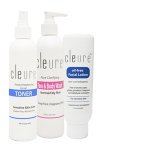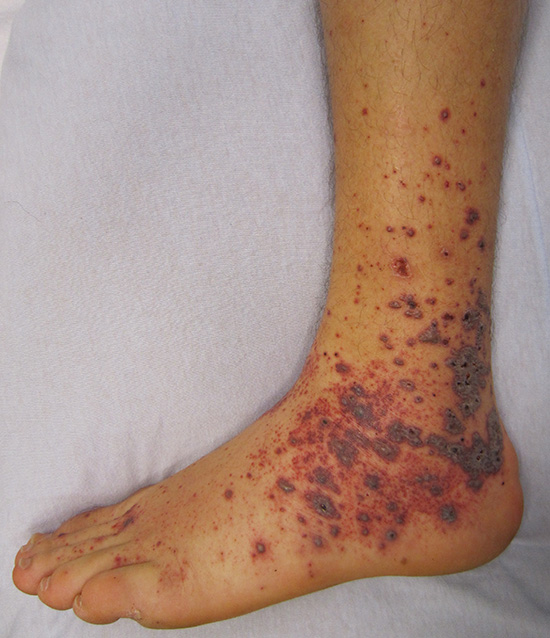Lupus Rash
Symptoms and Natural Remedies for
Lupus Skin Rash
Lupus rash is associated with the autoimmune disease called lupus. This disease compromises the immune system, causing it to actually attack the body rather than protecting it.
Lupus sufferers experience extreme, deep fatigue, pain in the joints, swelling around the joints, pain in the chest, migraine headaches, fogginess and difficulty thinking clearly, asthma-like symptoms, and dry eyes.
Another one of the physical challenges that comes with lupus is the rash that can break out on various areas of the body.
Three Types of Lupus Skin Rashes or Lesions
Chronic Cutaneous Lupus Erythematosus
The most severe of the three is called chronic cutaneous or discoid lupus erythematosus, showing up as lesions on the scalp, head, and occasionally on the face. Thankfully, the lesions don't cause pain and don't seem to itch, but they are characteristically unsightly. They form a thick cover over skin that is red and inflamed or flaky or all three at the same time.
Subacute Cutaneous Lesions
The second type of lupus rash is called subacute cutaneous lesions. These lesions show up mostly on the extremities or those areas that sunlight can typically reach if not purposely covered. Your arms, shoulders, legs, and neck are most often affected with lesions that appear circular in shape with red scaly edges.
Acute Cutaneous Lupus Lesions
Acute cutaneous lupus lesions are the third type of rash that can occur with lupus. This particular rash occurs when the lupus disease is out of remission and actively attacking your body. You might notice reddish skin and small bumps across the nose and cheeks or across your legs, arms or other areas of the body. This is the most distinctive rash to lupus, as when it shows up on the face, it resembles a butterfly shape.
Traditional Treatments for Lupus Rash
Your physician may prescribe one or more of the following, depending on the rash and other symptoms you are experiencing at the time.
- Topical ointments or gels containing steroids
- Drugs - Protopic® , Thalomid® , Elidel® to name only a very few
- NSAIDs
- Liquid steroids - injected at the site of the lesion
- Immunosuppresant drugs
- Antimalarial drugs
- Acetaminophin
Natural Remedies for Lupus Rash
There are many things you can do to avoid developing the rash that accompanies lupus symptoms. The easiest thing to do is to avoid direct sunlight. Stay out of the sun and in the shade when the sun is out, especially after 10 a.m. and up until around 4:00 or 4:30 p.m.
On those days you either have to be or want to be outside, apply a healthy sunscreen lotion to your body and wear clothing that is provides some protection against the sun. Light, airy clothing that won't stick to or irritate the skin is best. A stylish hat with a broad brim is also an excellent investment to keep the sun from hitting your face directly.
Believe it or not, fluorescent lights inside the house can also encourage the rash to appear, so stay away from these types of lights inside your home or office whenever possible. Consider switching to light bulbs that are iridescent if you can, especially in those areas of the home where you sit often or spend the most time.
You can treat the overall lupus disease, which includes the rash, by following some well-known guidelines for your health that will help your immune system.
- Get out and exercise regularly - it doesn't have to be anything intense, but move for at least 30 minutes 4 to 5 times per week. Even a gentle exercise like Y-Dan or Tai Chi will be beneficial.
- Give your body healthy foods - whole grains, fruits, vegetables, lean proteins, and healthy fats
- Lower your intake of sugars and unhealthy fats
- Lower your stress level - lupus symptoms can increase exponentially when you're experiencing high levels of stress.
- Therapies such as guided imagery or hypnosis can help relieve stress
- Quit smoking if you smoke - and don't start
- Fish oil and Omega 3 supplements
- Lose unnecessary weight
- Rest - it's vital to get your required amount of sleep each night, whether that's 7 hours or up to 9 hours each night
- Gather your best support via friends and family around you daily
- Vitamin D supplement - to provide what you're not getting in the shade
- Continue talking with your physician about ways to protect yourself
Can I Wear Makeup Over My Lupus Rash?
The short answer is, absolutely! Rashes on the skin can be embarrassing and frustrating, especially when you want to look your best for an outing or special event. You can wear makeup over your rash if you choose a product line that contains healthy and non-irritating ingredients for your skin.
We recommend the Cleure product line for people with rashes associated with lupus. This product line of skin care and cosmetics contains ingredients that are gentle to your skin. The skin care cleans your skin gently and the moisturizer gives the skin a silky feeling without being greasy.
The Cleure makeup goes on smoothly and covers gently without gathering around the small bumps or blemishes, while covering your skin beautifully.
Every woman should be able to look her best, even when struggling with a rash like lupus rash, but it's important to note that most over the counter cosmetics contain ingredients that could irritate your skin, which will just make your skin appear more inflamed and flaky.
We would urge you to check out our ingredient list at our Safe Cosmetics Guide to see what ingredients you should avoid altogether if you have sensitive skin. Our guess is that if you have lupus, you have sensitive skin, so cosmetics that are truly natural and hypoallergenic are the key for you.
Lupus rash can be controlled to a point if you take care of yourself, avoid direct sun as often as possible, rest regularly, and eat an excellent balance of foods daily.
Home > Pictures of Rashes > Lupus Rash









New! Comments
Share your thoughts about what you just read! Leave me a comment in the box below.